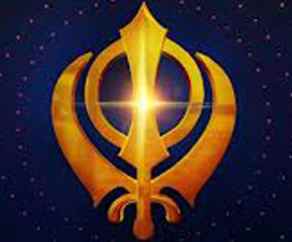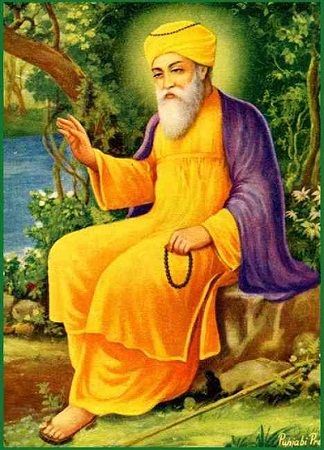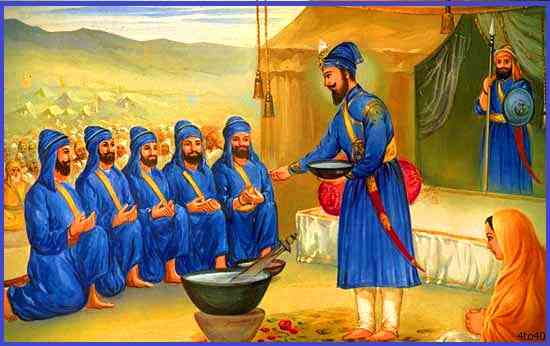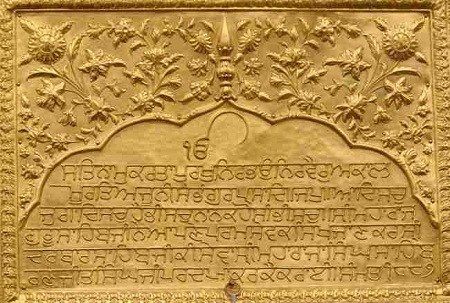- Sikhism -

A way of life and philosophy well ahead of its time when it was founded over 500 years ago, The Sikh religion today has a following of over 20 million people worldwide.
Sikhism preaches a message of -
devotion and remembrance of God at all times, truthful living, quality of mankind, social justice and denounces superstitions and blind rituals.
Sikhism is open to all through the teachings of its 10 Gurus enshrined in the Sikh Holy Book and Living Guru, Sri Guru Granth Sahib.
- Who and What is a Sikh ? -
The word 'Sikh' in the Punjabi language means 'disciple', Sikhs are the disciples of God who follow the writings and teachings of the Ten Sikh Gurus. The wisdom of these teachings in Sri Guru Granth Sahib are practical and universal in their appeal to all mankind.
"Any human being who faithfully believes in:
- One Immortal Being
- Ten Gurus, from Guru Nanak to Guru Gobind Singh
- The Guru Granth Sahib
- The utterances and teachings of the ten Gurus and
- The baptism bequeathed by the tenth Guru, and who does not owe allegiance to any other religion is a Sikh." - (Rehat Maryada, Sikh Code of Conduct)

- History -
The founder of the Sikh religion was Guru Nanak who was born in 1469. He preached a message of love and understanding and criticized the blind rituals of the Hindus and Muslims. Guru Nanak passed on his enlightened leadership of this new religion to nine successive Gurus. The final living Guru, Guru Gobind Singh died in 1708.
During his lifetime Guru Gobind Singh established the Khalsa order (meaning 'The Pure'), soldier-saints. The Khalsa uphold the highest Sikh virtues of commitment, dedication and a social conscious.

Before his death in 1708 Guru Gobind Singh declared that the Sikhs no longer needed a living and appointed his spiritual successor as Sri Guru Granth Sahib, his physical successor as the Khalsa. Guru Gobind Singh felt that all the wisdom needed by Sikhs for spiritual guidance in their daily lives could be found in Sri Guru Granth Sahib, the Eternal Guru of the Sikhs. Sri Guru Granth Sahib is unique in the world of religious scriptures because not only is it accorded the status of being the spiritual head of the Sikh religion, but besides the poetry of the Gurus, it also contains the writings of saints of other faiths whose thoughts were consistent with those of the Sikh Gurus.
- Practices -
Sikhism does not have priests, which were abolished by Guru Gobind Singh. The Guru felt that they had become corrupt and full of ego. Sikhs only have custodians of the Guru Granth Sahib (granthi), and any Sikh is free to read the Guru Granth Sahib in the Gurdwara (a Sikh temple) or in their home. All people of all religions are welcome to the Gurdwara. A free community kitchen can be found at every Gurdwara which serves meals to all people of all faiths. Guru Nanak first started this institution which outline the basic Sikh principles of service, humility and equality.

The most significant historical religious center for the Sikhs is Harmiandir Sahib (The Golden Temple) at Amritsar in the state of Punjab in northern India. It is the inspirational and historical center of Sikhism but is not a mandatory place of pilgrimage or worship. All places where Sri Guru Granth Sahib are installed are considered equally holy for Sikhs.
- Philosophy and Beliefs -
- There is only One God. He is the same God for all people of all religions.
- The soul goes through cycles of births and deaths before it reaches the human form. The goal of our life is to lead an exemplary existence so that one may merge with God. Sikhs should remember God at all times and practice living a virtuous and truthful life while maintaining a balance between their spiritual obligations and temporal obligations.
- The true path to achieving salvation and merging with God does not require renunciation of the world or celibacy, but living the life of a householder, earning a honest living and avoiding worldly temptations and sins.
- Sikhism condemns blind rituals such as fasting, visiting places of pilgrimage, superstitions, worship of the dead, idol worship etc.
- Sikhism preaches that people of different races, religions, or sex are all equal in the eyes of God. It teaches the full equality of men and women. Women can participate in any religious function or perform any Sikh ceremony or lead the congregation in prayer.

- The Khalsa -
"I have made this body and mind a sacrifice, a sacrificial offering to the Lord. Dedicating my body and mind, I have crossed over the terrifying world-ocean, and shaken off the fear of death." (Guru Arjan, Chant, pg. 576)
- Who and What is a Khalsa ? -
"He who keeps alight the unquenchable torch of truth, and never swerves from the thought of One God; he who has full love and confidence in God and does not put his faith, even by mistake, in fasting or the graves of Muslim saints, Hindu crematoriums, or Jogis places of sepulchre; he who recognises the One God and no pilgrimages, alms-giving, non-destruction of life, penances, or austerities; and in whose heart the light of the Perfect One shines, - he is to be recognised as a pure member of the Khalsa" (Guru Gobind Singh, 33 Swaiyyas)

The word "Khalsa" means "pure", Khalsa's are Sikhs which have undergone the sacred Amrit Ceremony initiated by the 10th Sikh Guru, Guru Gobind Singh. The Khalsa order was initially created on Baisakhi Day March 30 1699, with Guru Gobind Singh baptizing 5 Sikhs and then in turn asking the five Khalsa's to baptize him. Following this the Guru personally baptized thousands of men and women into the Khalsa order. The Khalsa baptism ceremony is undertaken as part of ones own personal spiritual evolution when the initiate is ready to fully live up to the high expectations of Guru Gobind Singh. All Sikhs are expected to be Khalsa or be working towards that objective.
The Khalsa baptism ceremony involves drinking of Amrit (sugar water stirred with a dagger) in the presence of 5 Khalsa Sikhs as well as the Guru Granth Sahib. The initiate is instructed in the following;
- You shall never remove any hair from any part of thy body
- You shall not use tobacco, alcohol or any other intoxicants
- You shall not eat the meat of an animal slaughtered the Muslim way
- You shall not commit adultery. The initiate is required to wear the physical symbols of a Khalsa at all times as well as follow the Khalsa Code of Conduct.
- Rehat Maryada -
What is the Rehat Maryada ?
This document is the Official Sikh Code of Conduct. There were a number of unsucessful attempts in the eighteenth century following the death of Guru Gobind Singh to produced an accurate portrayal of Sikh conduct and customs. These attempts were contradictory and inconsistent with many of the principles of the Gurus and were not accepted by the majority of Sikhs. Starting early this century in 1931 an attempt was made by the Shromani Gurdwara Parbandhak Committee (S.G.P.C.) to produce a modern standard Rehit. These efforts involved the greatest Sikh scholars and theologians of this century who worked to produce the current version. The document produced has been accepted as the official version which provides guidelines against which all Sikh individuals and communities around the world can measure themselves. The Rehat Maryada is the only version authorized by the Akal Takht, the seat of supreme temporal authority for Sikhs. It's implementation has sucessfully achieved a high level of uniformity in the religious and social practices of Sikhism.








